Development of Teaching Support Material for Nurturing Cooperation through Play
- DOI
- 10.2991/jrnal.2018.5.3.6How to use a DOI?
- Keywords
- Cooperation; teaching material; operation; evaluation
- Abstract
Educational activities with robots have been conducted at each stage – from kindergarten to junior high school. In this paper, we propose and verify educational material supporting collaborative operations through experiences related to people and objects. Specifically, three children used joysticks to operate a robot simultaneously. The robot could not move unless the joysticks manipulated it. We developed teaching support material that nurtured cooperation through play.
- Copyright
- © 2018 The Authors. Published by Atlantis Press SARL.
- Open Access
- This is an open access article under the CC BY-NC license (http://creativecommons.org/licences/by-nc/4.0/).
1. INTRODUCTION
An emerging problem in Japan is that coordination (cooperative and collaborative work, etc.) through appropriate group activities has not been assimilated by the country’s changing social situations. Specific problems include the following:
- 1.
People are unable to build good human relationships with others.
- 2.
People are unable to work in groups.
- 3.
People are unable to solve problems with other people through discussion.
In addition, it has been noted that Japanese children cannot successfully adapt to groups in kindergartens and elementary schools [1].
Conversely, in November 2014, the Japanese Minister of Education, Culture, Sports, Science and Technology consulted the Central Education Council who emphasized the quality and quantity of knowledge and learning, learning subjectively and collaboratively, learning to identify and resolve problems, and improving teaching methods. Hence, abundant research exists on learning methods in educational subjects [2–4]. However, there has been scarce research on nurturing cooperation using robots. Such research is important for personality development education.
Therefore, this study, proposes and develops cooperative teaching material and evaluates cooperation among children. Specifically, we provide children joysticks to operate a modified robot that does not move unless they manipulate it simultaneously.
2. PROPOSED TEACHING MATERIAL
The proposed teaching material is displayed in Figure 1 with the following concept:
- 1.
Three children cooperate in maneuvering.
- 2.
Remote control type (joystick).
- 3.
Data recording (using a data logger).
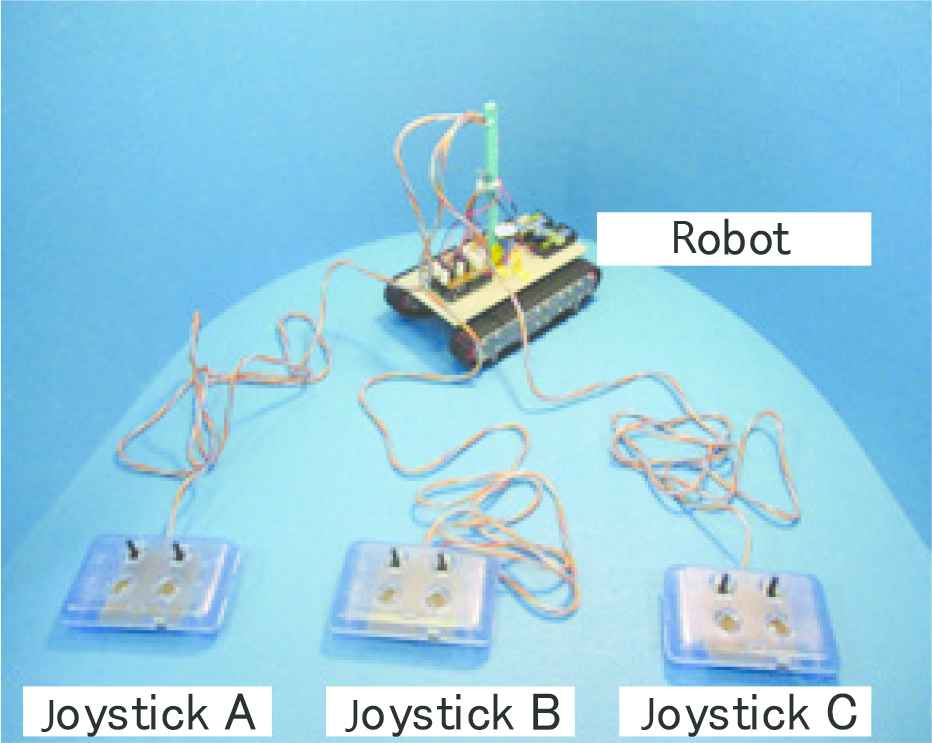
Proposed teaching material
Figure 2 indicates the system configuration for this teaching material. The joystick statuses (0 V or 5 V) of the three children are sent to a micro-controller [5]. Subsequently, the status of each joystick is stored in the data logger by the micro-controller or the data is transferred to a tablet PC through Bluetooth.
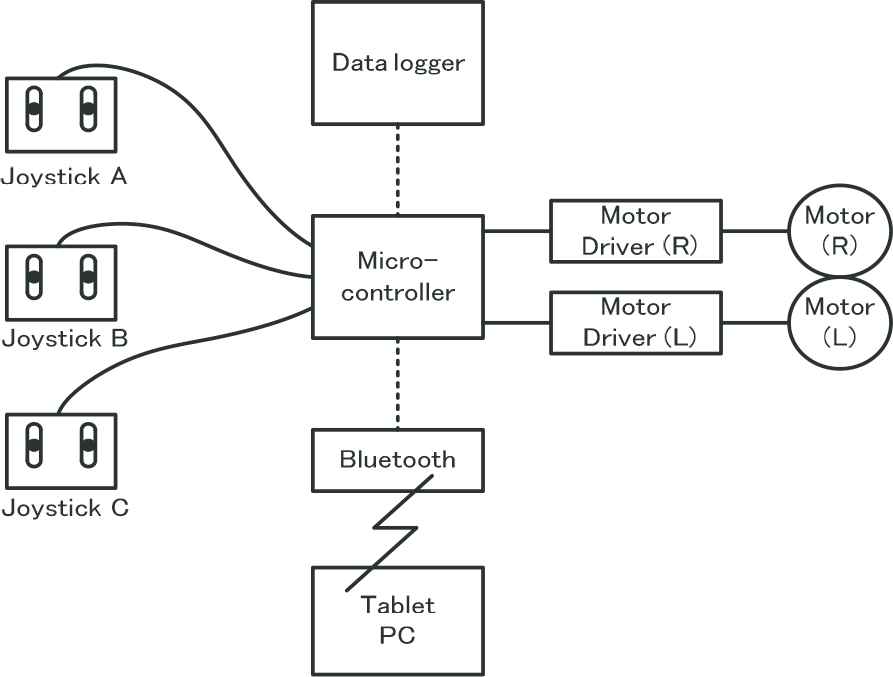
Schematic figure of proposed teaching material
The algorithm for operating this teaching material is adapted to adjust the speed of the robot’s crawlers by the following Eqs. (1)–(4):
Furthermore, JS1R (JS1L), JS2R (JS2L), and JS3R (JS3L) denote signals on the right side (the left side) of the joysticks of operators A, B, and C, respectively. The left and right sides of the joysticks are set to 0 when the robot is not moving, 1 when it is moving forward, and −1 when it is moving backward.
MDR (MDL) denotes the sum of JS1R, JS2R, and JS3R (the sum of JS1L, JS2L, and JS3L), and the signal of a majority decision by the operators is the output, as shown in Figure 3. With these signals of a majority decision, the robot cannot move unless an individual operator cooperatively manipulates their device with the other operators.
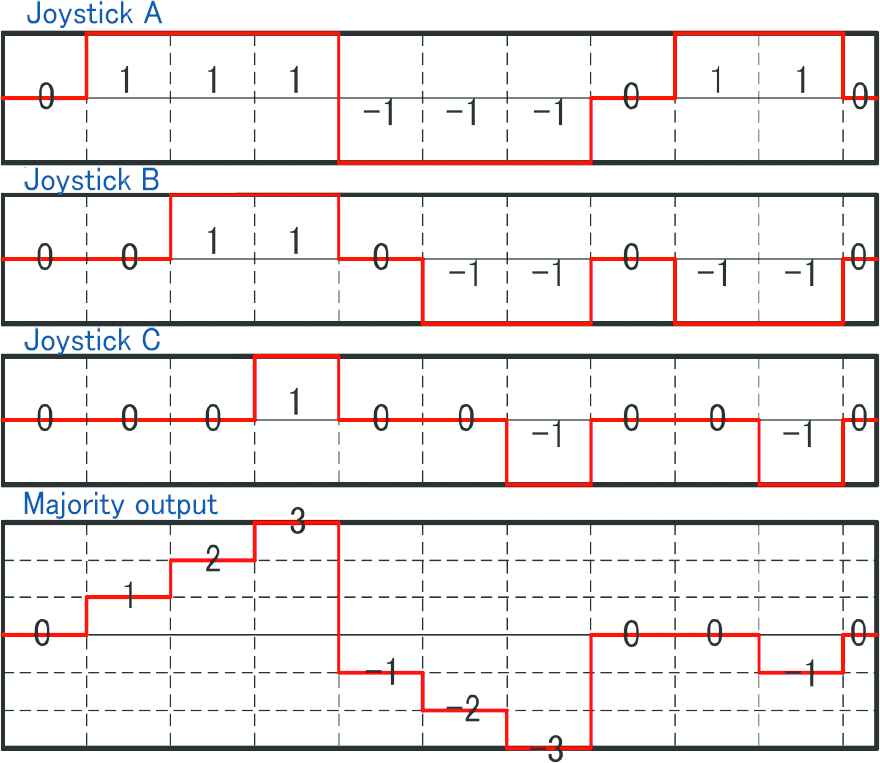
Majority decision
3. CURRICULUM FOR NURTURING COOPERATION
The curriculum for nurturing cooperation using the suggested teaching methods is explained here. Since this method is to be used in elementary school classes as indicated in Table 1 this curriculum is conducted in 90 min classes (45 min, twice).
| Time (min) | Content |
|---|---|
| 10 | Learning about cooperation |
| 20 | Learning about rescue activities |
| 15 | Rescue activities without talking |
| 15 | Rescue activities with talking |
| 20 | Rescue activities based on a leader’s instructions |
| 10 | Summarize the lesson |
Curriculum
The lesson objectives are explained in the first 10 min. The following 20 min clarify the rescue activities using the proposed teaching material, rescue field (Figure 4), and rescue dummy (Figure 5). At this point, students are instructed that the robot must swiftly move to the dummy location for rescue. Moreover, the students with joysticks rescue the dummy without talking for 15 min. During the next 15 min, they rescue dummy while discussing the task. For another 20 min, they rescue the dummy according to the leader’s instructions. Finally, the importance of cooperation is summarized.
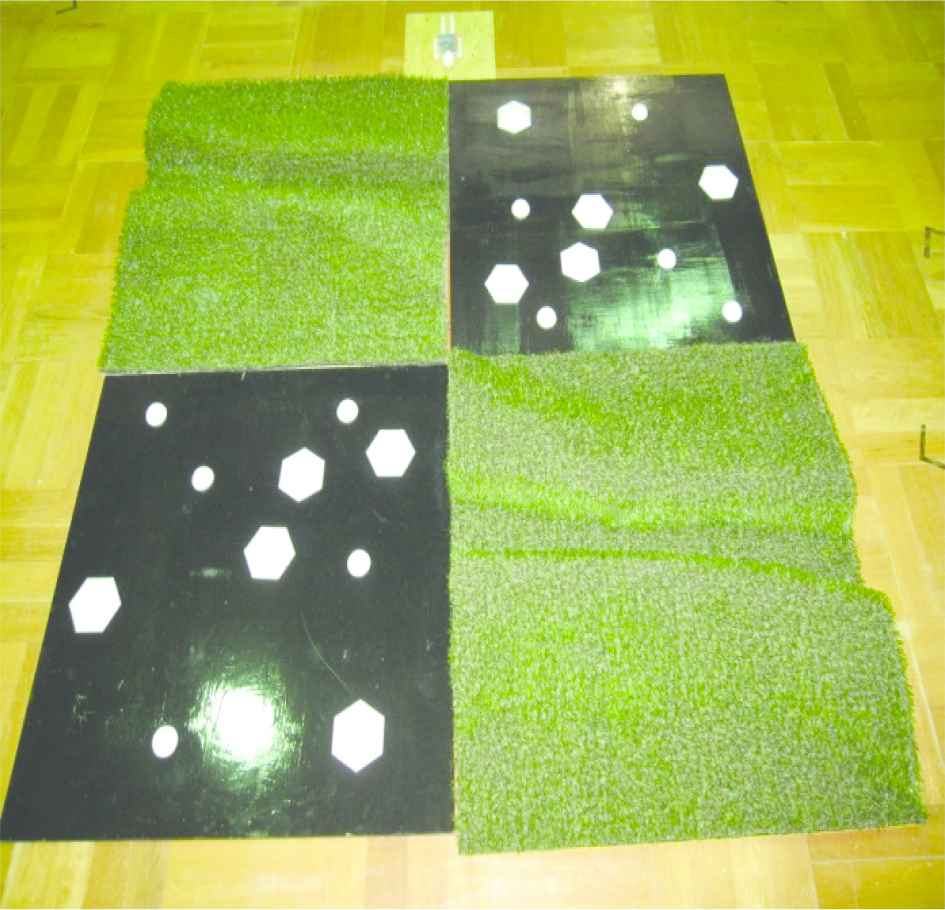
Rescue field
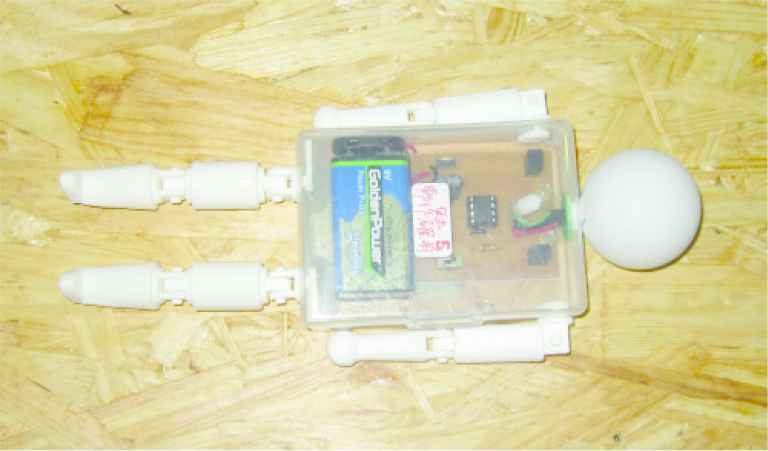
Rescue dummy
4. EXPERIMENTS AND RESULTS
We experimented to confirm the effectiveness of the teaching materials. The participants were three elementary school students. In the following two cases, the joystick statuses were compared and the effectiveness of the teaching material was confirmed.
Case 1: Three students operate the robot without talking.
Case 2: Students operate the robot according to a leader’s (selected from the three students) instructions.
Figures 6 and 7 demonstrate the joystick operation behavior of the students in Case 1. If the operations of the three students correspond, the MDR and MDL values are −3 or 0 or 3. It is obvious that the students are not cooperating because in several instances numerical values other than −3 or 0 or 3 occur.
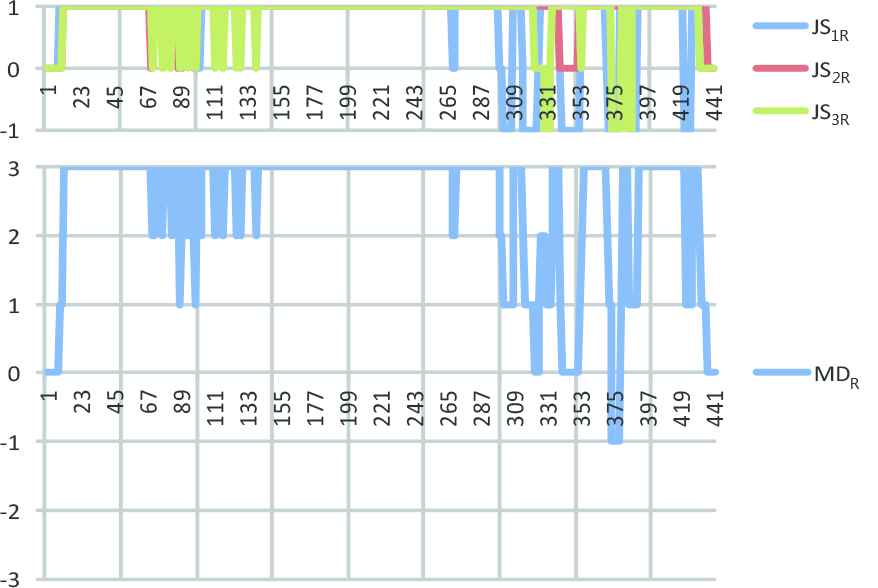
Right joystick operation behavior in Case 1
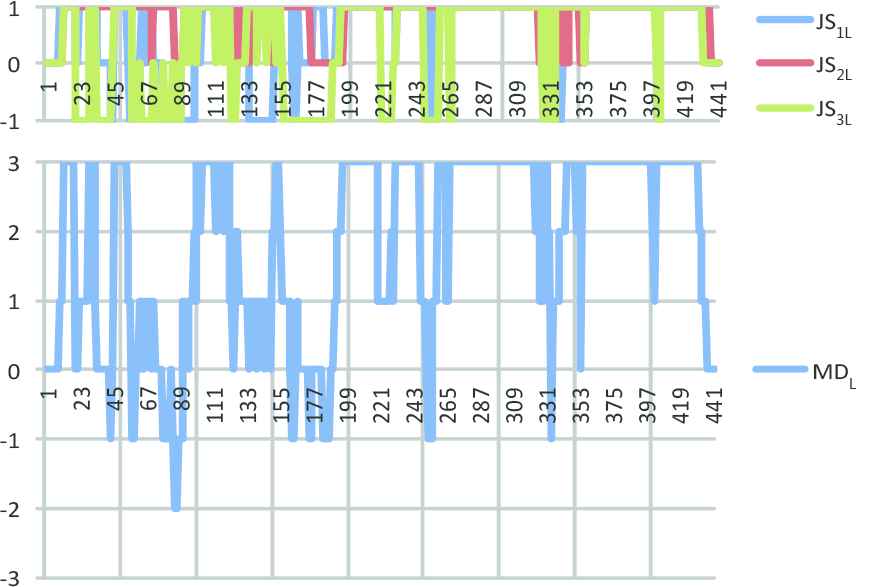
Left joystick operation behavior in Case 1
Figures 8 and 9 indicate the joystick operation behavior of the students in Case 2. Since the operations of the three students almost concur, the numerical values of MDR and MDL are −3 or 0 or 3. Hence, it is obvious that cooperative operations are possible through a leader’s instructions. Moreover, when the three students cooperatively operate the robot their joystick behavior synchronizes.

Right joystick operation behavior in Case 2

Left joystick operation behavior in Case 2
5. CONCLUSION
This paper offered teaching material to support cooperative development through direct experiences. The experimental results using the proposed teaching material indicated that joystick operations synchronized when students operated cooperatively.
In the future, we intend to develop the teaching material and curriculum and put them into practice at an elementary school. We will utilize questionnaires to reveal the opinions of students and teachers to verify its effectiveness.
Authors Introduction
Mr. Kazuo Kawada
 He graduated Doctor course at Department of Technology and Information Education in Hiroshima University. He is an Associate Professor in the Department of Technology and Information Education at Hiroshima University. SICE, IEEJ member.
He graduated Doctor course at Department of Technology and Information Education in Hiroshima University. He is an Associate Professor in the Department of Technology and Information Education at Hiroshima University. SICE, IEEJ member.
Mr. Teruyuki Tamai
 He graduated Master course at Department of Technology and Information Education in Hiroshima University. He is an Assistant Professor in the Faculty of Education in Ehime University. He is a JSTE member.
He graduated Master course at Department of Technology and Information Education in Hiroshima University. He is an Assistant Professor in the Faculty of Education in Ehime University. He is a JSTE member.
REFERENCES
Cite this article
TY - JOUR AU - Kazuo Kawada AU - Teruyuki Tamai PY - 2018 DA - 2018/12/01 TI - Development of Teaching Support Material for Nurturing Cooperation through Play JO - Journal of Robotics, Networking and Artificial Life SP - 169 EP - 172 VL - 5 IS - 3 SN - 2352-6386 UR - https://doi.org/10.2991/jrnal.2018.5.3.6 DO - 10.2991/jrnal.2018.5.3.6 ID - Kawada2018 ER -
